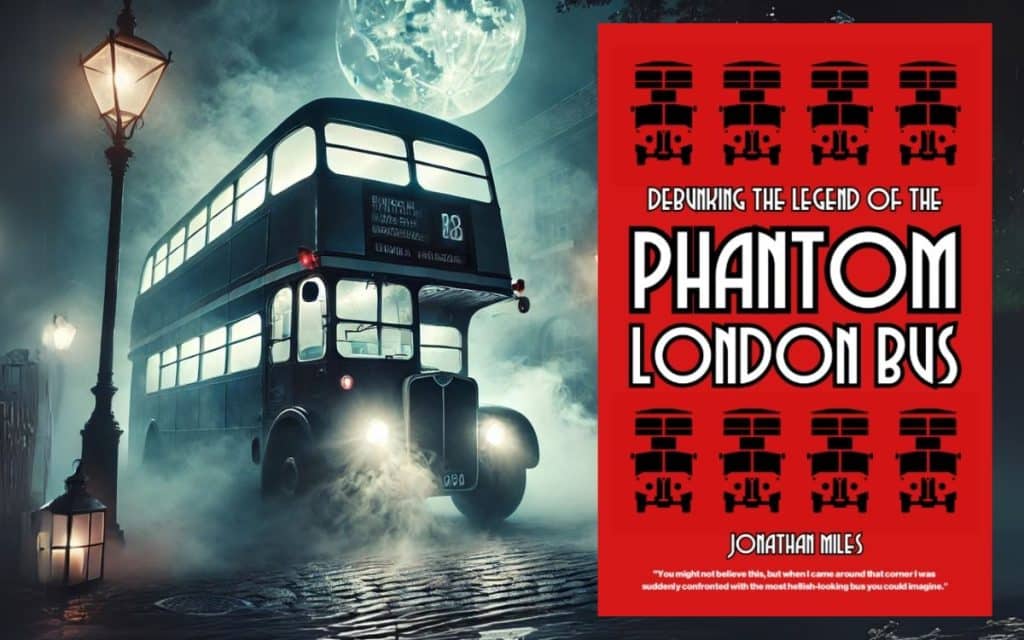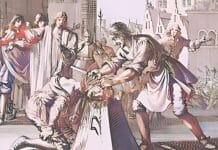Jonathon Miles, a historian and paranormal researcher, has spent years investigating one of London’s most intriguing ghost stories – the legend of the phantom double-decker bus of North Kensington. Speaking to DAVID SAUNDERSON, he discusses his new book and shares the origins of the tale, how it evolved into urban folklore, and whether there’s any truth behind the haunting.

Spooky Isles: Tell us about the haunting – what is the story of the phantom double-decker bus, and how did it become such an iconic part of London’s supernatural folklore?
Jonathon: The Phantom London bus was said to thunder through the empty streets of North Kensington in the early hours, brightly lit but with no driver, conductor, or passengers. The case first gained attention in the early 1930s. The bus was thought to be a bad omen, particularly for motorists at the junction of St Mark’s Road and Cambridge Gardens, where it was said to cause drivers to swerve and lose control before vanishing into thin air. Blamed for multiple accidents, it was allegedly seen as recently as 1990. This is a classic modern British ghost story, featuring an iconic London image, dark and lonely streets, and a touch of Art Deco mystery.
Spooky Isles: Why did you decide to write a whole book on this specific case? What drew you to the phantom bus compared to other ghost stories?
Jonathon: My lifelong interest in the Phantom London bus began when I was seven years old at Christmas 1980, after receiving the excellent Hamlyn Book of Ghosts by Daniel Farson. The story fascinated me then, and it still does today. Like my other interest in Jack the Ripper and the Whitechapel Murders, the story paints a vivid picture of London in the past.
You might expect such an extraordinary tale to have been the subject of entire books already, but that’s not the case. The story is usually included alongside other ghostly legends, often with exaggerated or inaccurate details. Over time, repeated retellings have distorted the facts. After years of research, my book presents the most complete and accurate account of this fascinating ghost story and offers my view on what really happened on the streets of North Kensington 92 years ago.
Spooky Isles: In your research, what did you uncover about the origins of the story? How much of it is based on eyewitness accounts versus later embellishments?
Jonathon: From my research, I believe the legend of the phantom bus did not start with a clear, well-documented supernatural sighting but instead came from a sarcastic exchange between a bus conductor and a confused passenger around 1931 or 1932. This story then spread among locals in North Kensington and evolved into the tale we know today, making it more of an urban legend than a genuine ghost story.
Most reports of the phantom bus date from 1932 to 1934, when UK and global press coverage was at its peak. After 1934, most references to the story were retrospective. Almost all alleged sightings come from second- and third-hand accounts. Few, if any, first-hand witnesses ever documented their experiences. Most reports come from people saying they heard it from a friend who heard it from someone else, making the bulk of accounts unreliable.
Spooky Isles: What are some of the most surprising or lesser-known details you discovered while researching this case?
Jonathon: The most surprising thing was that the story didn’t receive even more attention at the time and that those who supposedly saw the phantom bus didn’t document their experiences later. Of course, by 1939, the Second World War had begun, and people likely had more pressing concerns than a ghost bus.
For those interested in London’s darker past, the haunted junction is only about 100 metres from the former site of 10 Rillington Place, where John Reginald Christie murdered at least eight people between 1943 and 1953. Also, a flat at 100 Cambridge Gardens, overlooking the junction, was once home to musician Steve Peregrin Took (1949–1980), co-founder of Tyrannosaurus Rex (later T. Rex) with Marc Bolan.
Spooky Isles: What do you think might have been happening in North Kensington in the 1930s to give rise to these sightings? Was it truly paranormal, or could there be a more rational explanation?
Jonathon: North Kensington’s roads and junctions were dangerous in the 1930s, with many people killed or injured in everyday accidents. Buses were often involved in these incidents, and the public were unhappy with both the buses and the authorities’ approach to road safety. What better way to draw attention to the issue than to spread the idea of a phantom bus as part of the problem?
A fast-moving, empty bus with bright lights might well have been seen late at night, and it may have caused drivers to swerve. But was it supernatural? Probably not. There’s far more evidence suggesting these were real buses being driven at high speed back to their depots at the end of their service. My book provides rational explanations for what was likely mistaken as a ghostly phenomenon.
Spooky Isles: The phantom bus was last allegedly seen in 1990. Do you think it could reappear, and if so, what might be the circumstances for such a sighting?
Jonathon: In the future, will someone walking home from the pub or driving through a dark North Kensington street claim to see an odd-looking, empty bus behaving strangely? Most likely, yes. But will it be a ghost bus? I’m still waiting for a solid first-hand account of a truly supernatural bus. Since the mid-1930s, sightings have been rare.
Spooky Isles: Why do you think stories like this continue to captivate people, and what does the phantom bus tell us about London’s relationship with its own history and folklore?
Jonathon: This story still fascinates me and many others. Whether or not you believe in the phantom bus, the image of an iconic London double-decker speeding through deserted streets at night is compelling. A part of me still wants to believe it!
Debunking the Legend of the Phantom London Bus by Jonathan Miles is available from Amazon.
What do you think of the legend of the Phantom London Bus? Tell us in the comments section below!








I’ll buy the ‘returning to depot’explanation. Before creation of the M8 motorway from Glasgow to Edinburgh, the A8 was a notorious ‘killer road’ with only ‘Slow’ signs on junctions crossing it, which the authorities refused to alter to ‘Stop’ signs. There were fatal accidents on the weekends before and after mine, at the junction where I came to grief, and it was eventually designated a Black Spot. The problem was worsened because bus drivers returning to Depot would turn off the interior lights, in defiance of instructions, to avoid would-be passengers trying to flag them down.
In August 1964 I was driving after dark on a Lambretta to a late-night jazz concert by Chris Barber at the Edinburgh Festival. At one of the junctions beyond Bathgate, an unlit bus came out from behind a row of trees and despite braking, I collided with it between the rear stairs and the end of the bus. The driver tried to maintain that I was driving without lights, but a friend on another Lambretta pointed out that my headlight was still on. I could describe it shining on the side of the bus, and had the colour right, while analysis proved that he must have seen me and braked, otherwise I would have missed him. Although I was wearing a helmet I had severe concussion, bad leg cuts and minor back injuries, but I was left with a bad facial scar from going through the Lambretta windshield, and a year later I grew a beard to hide it which I still have.
I missed a University exam which I was well prepared for, but had to repeat a year in consequence. The bus driver was prosecuted for dangerous driving, at which point I received £400 in compensation, which was a mixed blessing at first. It enabled me to spend vacations writing from then on, and launched my career an author, partly because after I graduated I couldn’t get a decent job because I had no references. The head injury proved to have longer-term consequences – seemingly I had a pinpoint brain haemorrhage which wasn’t diagnosed at the time, but I got over them. Had I known I had a brain injury I might have got a lot more compensation, but I count myself lucky that I didn’t end up haunting the crossroads and adding another case to the Spooky Isles files!